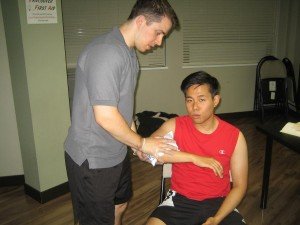An individual with fluid on the elbow is a condition called as elbow bursitis. The condition is often due to the accumulation of fluid in the bursa which is a sac-like structure situated at the point behind the elbow. It is important to note that this sac allows smooth movement in the elbow, allowing the individual to easily throw, hold and pick objects. Once these sacs become inflamed, the individual should consult a doctor so that the appropriate treatment for elbow bursitis can be given.
RICE method for fluid on the elbow
The RICE method has been the initial mode of treatment for injuries that aims to relieve pain and inflammation. The RICE method (rest, ice, compression, elevation) can be used to treat fluid on the elbow. Initially, instruct the individual to rest his/her elbow whenever possible to minimize the swelling and avoid the condition from progressing.

The application of an ice pack for 15-20 minutes at a time for three to four times in a day can help reduce the swelling. Always remember that the ice pack must be wrapped in a clean towel or cloth before applied on the skin to prevent frostbite from developing. Compression can be used to prevent swelling but must be used carefully to prevent disrupting the oxygen supply to the fingers. Lastly, elevate the affected arm higher than the level of the heart by propping on a cushion or pillow or a pile of blankets. The RICE method is one of the basic first aid measures that is included in a first aid class.
Drainage
Since the accumulation of fluid in the elbow bursa is responsible for the pain and inflammation of fluid on the elbow, it might be required to drain the fluid. The drainage procedure involves the insertion of a needle to drain fluid from the bursa. If there are no signs of infection during the procedure, cortisone is given to help control the inflammation and ease the pain of this condition.
Physical therapy
Physical therapy is utilized in order to treat the pain of fluid on the elbow. The exercise performed during physical therapy will help strengthen the elbow and make it possible to achieve a wider range of motion. Ultrasound is also used to improve the flow of blood to the area where the fluid accumulated. This will help provide deep heat that can minimize the inflammation. Take note that ultrasound can also activate cortisone cream that has been applied to areas where there is pain and inflammation caused by fluid on the elbow.
Anti-inflammatory medications
Non-steroidal anti-inflammatory drugs (NSAIDs) can be utilized to control the pain and inflammation of the bursa. It is important that these medications are readily available without a prescription but should not be used without consulting a doctor. The intake of NSAIDs can increase the risk of gastrointestinal bleeding and can be dangerous for those who have diminished kidney function. When NSAIDs are used to treat bursitis, it is important to follow the instructions carefully and the package instructions must be read carefully to avoid the detrimental side effects. Commonly used NSAIDs include naproxen and ibuprofen.
Cortisone injections
Cortisone injections are utilized to treat the inflammation of fluid on the elbow as well as long-term relief of pain due to the condition. The cortisone works by suppressing the inflammatory response of the body which results to diminished level of pain. Even though these injections are effective in reducing the inflammation but there are risks involved. The possible risks of cortisone injections include joint infection, nerve damage, weakened tendons, bone death, thinning of the skin and bone as well as whitening of the skin surrounding the site of injection.
